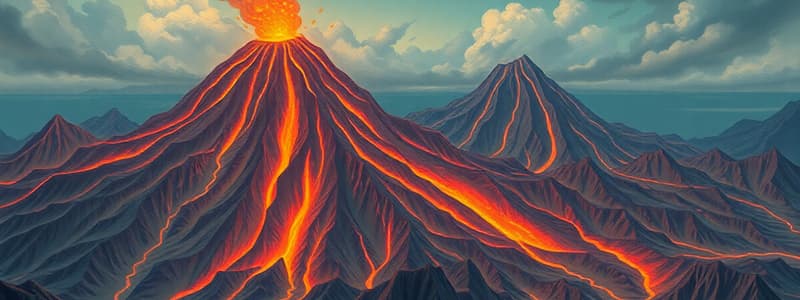Podcast
Questions and Answers
What is the molten rock beneath the Earth's crust called?
What is the molten rock beneath the Earth's crust called?
Volcanoes can only form at the Earth's surface.
Volcanoes can only form at the Earth's surface.
False
What are the three types of seismic waves?
What are the three types of seismic waves?
P-waves, S-waves, surface waves
The location where an earthquake starts is called the ______.
The location where an earthquake starts is called the ______.
Signup and view all the answers
Match each type of wave with its description:
Match each type of wave with its description:
Signup and view all the answers
Where do hot spot volcanoes typically form?
Where do hot spot volcanoes typically form?
Signup and view all the answers
Most volcanoes are found at convergent plate boundaries.
Most volcanoes are found at convergent plate boundaries.
Signup and view all the answers
The area surrounding the Pacific Ocean known for its high volcanic activity is called the ______.
The area surrounding the Pacific Ocean known for its high volcanic activity is called the ______.
Signup and view all the answers
Which type of plate boundary is characterized by plates moving away from each other?
Which type of plate boundary is characterized by plates moving away from each other?
Signup and view all the answers
Converging boundaries can create new crust.
Converging boundaries can create new crust.
Signup and view all the answers
What is the process called when an oceanic plate is pushed under a continental plate?
What is the process called when an oceanic plate is pushed under a continental plate?
Signup and view all the answers
______________ islands are formed when two oceanic plates collide and one undergoes subduction.
______________ islands are formed when two oceanic plates collide and one undergoes subduction.
Signup and view all the answers
Which of the following statements about divergent boundaries is true?
Which of the following statements about divergent boundaries is true?
Signup and view all the answers
Match the following boundary types with their characteristics:
Match the following boundary types with their characteristics:
Signup and view all the answers
Iceland is growing as a result of converging plate boundaries.
Iceland is growing as a result of converging plate boundaries.
Signup and view all the answers
What forms when continental plates collide?
What forms when continental plates collide?
Signup and view all the answers
Study Notes
Volcanoes
- Volcanoes form where extremely hot molten rock (magma) collects below weak spots in Earth's crust.
- During eruptions, magma is forcefully pushed to the surface as lava.
- Lava, at around 1200°C, cools and solidifies to create new rock.
- Gas, ash, and solid rock are often released during volcanic eruptions.
Volcanoes at Plate Boundaries
- Plate boundaries mark areas where Earth's crust is thinnest and weakest.
- Divergent boundaries develop weaknesses in the crust as plates separate, allowing magma to rise.
- Convergent boundaries also create weak spots as the subducting plate melts, causing magma to rise and form volcanoes.
Hot Spot Volcanoes
- Hot spots are isolated, weak points in the crust, located away from plate boundaries.
- The exact cause of hot spots remains unknown.
- A hot spot creates a volcano/volcanic island directly above it.
- As the tectonic plate moves over a hot spot, a chain of volcanoes develops, with older islands further away from the current hotspot. Examples include the Hawaiian Islands.
Earthquakes
- Tectonic plates are usually held together by friction.
- When external forces overcome friction, plates slip, releasing energy waves into the surrounding rock or water.
- These energy waves are called seismic waves.
Types of Seismic Waves
- Primary waves (P-waves): longitudinal; travel fastest.
- Secondary waves (S-waves): transverse; travel slower than P-waves.
- Surface waves: rolling motion; slowest, cause the most destruction.
Where Earthquakes Occur
- Earthquakes are most frequent at plate boundaries, particularly convergent boundaries where plates collide.
Earthquake Focus and Epicenter
- Focus: the starting point of the quake, located hundreds of kilometers underground.
- Epicenter: the location directly above the focus, at the surface.
How Earthquakes Are Detected
- Seismometers are used to detect earthquakes.
- Early seismometers used a weighted pencil on a rotating drum, enabling the drum to move with the quake but not the pencil, allowing the movement to be recorded.
- Later versions, like the Chinese seismometers, used a system of balls and dragons to detect the direction of movement.
Measuring Earthquake Magnitude
- Earthquake severity is measured using the Richter scale, a logarithmic scale.
- Each number on the scale represents a ten-fold increase in the earthquake's destructive power (e.g., magnitude 5.0 is ten times more destructive than magnitude 4.0).
Tectonic History of Australia
- Australia's lithosphere is significantly thicker than other continents.
- Australia does not sit on a plate boundary, which prevents continental rock from being destroyed.
- Some of the rock in the Australian continent is very old and helps us understand its geological history and how the continent drifted from being part of the Pangea supercontinent.
Studying That Suits You
Use AI to generate personalized quizzes and flashcards to suit your learning preferences.
Description
Explore the fascinating world of volcanoes formed by tectonic activity. This quiz covers how volcanoes relate to plate boundaries and hot spots, including their formation, eruptions, and geological significance. Test your understanding of these powerful natural phenomena!




